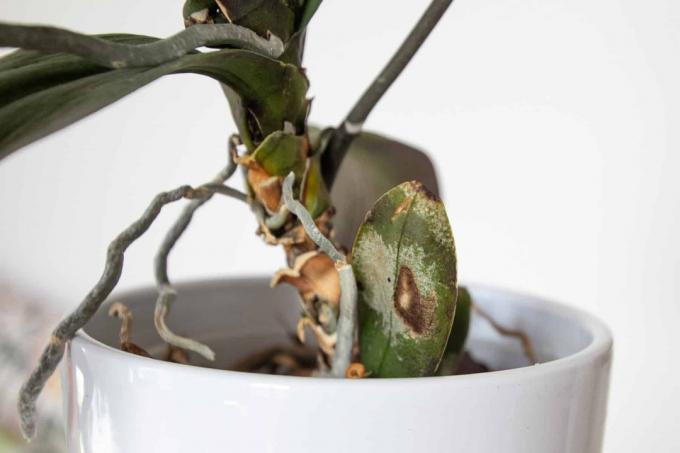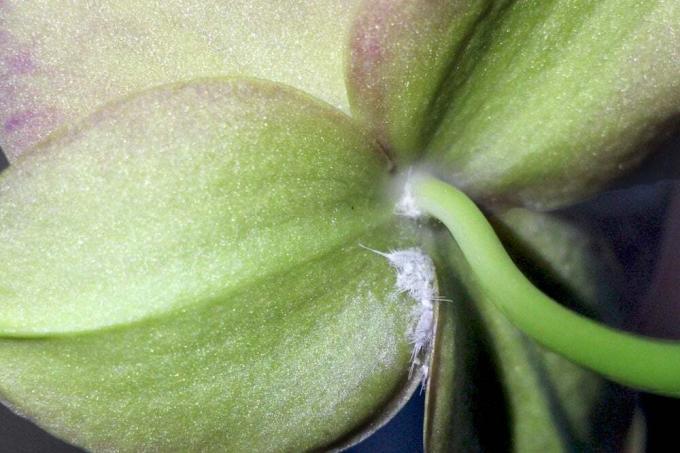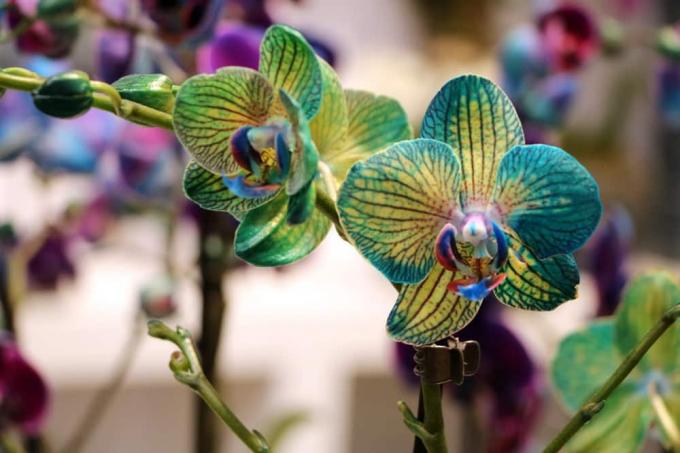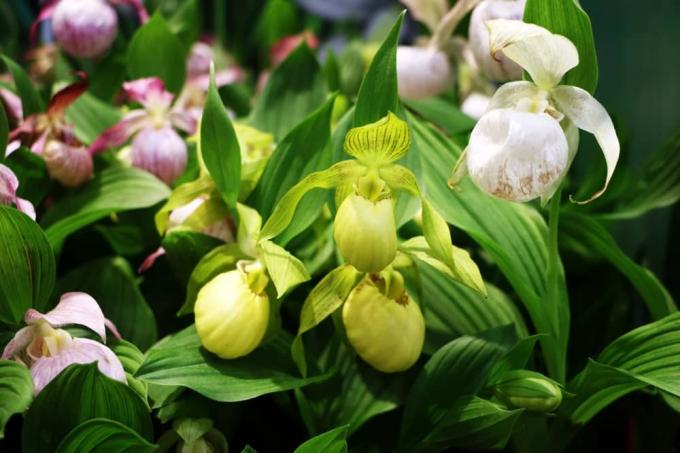

Table of contents
- demarcation
- Completely normal
- fungal disease
- Quality
- Location
- root damage
- Diseases
- fungal diseases
- bacterial infection
- viral infection
- rot
- Conclusion
Unfortunately, orchid diseases are an issue because their natural living conditions are very different from those in our living rooms. After all, not everyone has a tropical house in their garden. If something is wrong with the orchid, you have to recognize this first, then classify it correctly and treat it accordingly. Basically, it doesn't work any differently than it does for us humans. Mild cases can still be managed quite well, in severe cases it may be necessary to consult a specialist.
demarcation
Using the example of falling leaves on an orchid, it is easy to describe how closely you have to look to find the right cause. Only then can the right measures be taken afterwards.
Example:The leaves of an orchid turn yellow and fall off.
Completely normal
Most orchids shed a leaf or two from time to time. There are even genera that lose all their leaves at a certain point in time (before, but also after flowering).
fungal disease
In the initial phase, the spread of a fungus is still invisible. If you notice the external damage, it may already be too late for the orchid.
Quality
Many of the inexpensive orchids sold in supermarkets are "turbo grown". That is, they were raised with excessive amounts of fertilizer in a short period of time. Now it may be that after two years it will become limp and lose its leaves. Only with a lot of patience can it be pampered again.
Location
If the orchid is too dark, this will be answered with leaf shedding. In the further course diseases and pests can attack them.
root damage
Damage to the roots can show up on the surface due to leaf shedding. Old substrate and too much moisture is usually the cause.
This is only a small excerpt of the causes that can have leaf dieback. It is definitely worth taking a closer look and analyzing.
Diseases
There are three types of diseases that can become dangerous for an orchid:
- fungal diseases
- bacterial diseases
- viral diseases
It is not always easy for the layperson to clearly differentiate and it can often be too late when the first damage is visible. In all cases, however, the affected orchid must be separated from other plants immediately. Because all three pathogens are contagious and can spread to neighboring plants by touch and through the air.
fungal diseases
If the leaves develop brown-black, often sunken, spots, it is usually black spot disease. It is usually caused by care errors:
- too frequent spraying of the leaves in the evening hours
- too frequent watering during rest
- too high humidity
- poor ventilation

Now it's time to act quickly and isolate the plant immediately. Cut off the affected leaves with a sharp and disinfected cutting tool. Then improve the care measures: First, avoid spraying altogether or postpone it to the morning hours. Ensure a bright location and good ventilation. The types of fungi that cause these spots can be different. Different fungicides are often only effective against a specific species. It is only possible to differentiate here with the necessary specialist knowledge. Therefore, the use of fungicides after a self-diagnosis is not appropriate. Even home remedies don't help in every case. Still, it's always worth a try before giving up the plant altogether.
The following home remedies can be used for any type of suspected fungal disease:
Cinammon
To do this, dissolve 1 teaspoon of cinnamon in a cup of water by stirring vigorously. This mixture is then spread with a brush on all the leaves of the orchid.
Garlic
For a garlic broth, crush approx. 5 cloves and pour hot, not boiling, water on them. This mixture is allowed to steep overnight. The brew is then filtered off and placed in a spray bottle. Now it is sprayed undiluted on the leaves. Diluted 1:1 with water you can also water the orchid with it.
charcoal powder
To limit further spread, it is also recommended to sprinkle the stains with powdered charcoal. However, one should hardly catch all spores with it and it can only be a kind of first aid. An ugly, white-grey coating on the leaves suggests gray mold. This disease is often brought in with the purchase of the plant. Gray mold tends to form where there is poor ventilation and too much moisture, such as in plastic wrap packaging. A particularly nasty fungal disease can affect the species of Vanda and Ascocenda in particular: Thai disease. This fungus climbs into the conductive pathways of the leaves from below. By the time you notice the loss of leaves, it is usually too late. But sometimes the orchid has formed roots in the upper parts of the plant, so to speak as an emergency program. You can cut off this head cutting and try again. Unfortunately, the plant itself can then no longer be saved.
bacterial infection
A bacterial infection can only be recognized by small, brown and sharply defined spots on the leaves. Around the spots it can be slimy and have a moist shimmer. They get bigger and cause the leaves to die off. In particular, orchids with softer leaves, such as the Phalaenopses species, seem to be prone to this, especially in the wintertime or when they otherwise get too little light. Then immediate damage limitation is called for. The plant must stand separately and the whole place must be thoroughly cleaned and disinfected. Hydrogen peroxide is good for this. The damaged leaves are generously removed with a disinfected knife. The plant itself and also the neighboring plants must be immersed in a disinfectant suitable for orchids. When doing this work, don't forget to disinfect your hands and tools again with every cut. Lapacho tea is always recommended as a gentle means of disinfecting orchids. Maybe it's worth a try: 2 tablespoons of lapacho bark are added to one liter of water and boiled for a few minutes, then left to steep and the plants immersed in it. The measures already show that bacteria are not to be trifled with and it may be better to dispose of the infected plant completely before the bacteria spread further. For larger crops, you should definitely consult a specialist.
viral infection
A virus infection is noticeable by many small striped and arrow-shaped spots on the leaves. Here, too, it is very difficult for the layperson to tell whether it is a virus or a bacteria. While thorough disinfection can still work against bacteria, there is hardly any remedy against viruses. Fortunately, viral infections are not common. The Cymbidium, Cattleya and Odontoglossum seem to be particularly susceptible. Until the final clarification by the appropriate specialists, the plants should be isolated. Viruses are mostly transmitted by pests and unclean cutting tools.
Tip:
As a precaution, always make cuts on an orchid with disinfected tools. Daily watering should include a thorough inspection of the plant for pests.
rot
Fungal and bacterial diseases in particular are often preceded by rot. The cause is always too much water. The root area and the heart of the orchid are particularly susceptible to standing water. Likewise the areas between the bulbs and the leaves. The best measures to prevent rot:
- water and spray in the morning hours
- enough fresh air
- not too high humidity (especially in winter)
- sparing watering in winter (at cooler temperatures and less light)
- good initial supply of interfaces
- clean tool
An alternative remedy for rotten spots is oregano oil. A drop of this mixed with 1 tablespoon of regular oil is spread around the rotting parts of the plant with a brush. As a result, it dries out there and you can remove the rotten parts. After that, of course, correct the care according to the recommendations.
Conclusion
The difficulty of fighting certain diseases should not deter prospective orchid lovers from enjoying their hobby. That can at least be an incentive to deal with the theoretical needs of these impressive exotics a little. Chemical agents, such as those used in specialist areas, should not be used in the private sphere.
 garden editorial
garden editorial I write about everything that interests me in my garden.
Learn more about orchid species

Fight pests on orchids - ways against lice & vermin
Orchids are popular indoor plants and are often given as gifts, but unfortunately they are also occasionally attacked by pests - and these can cause considerable damage to the plants. Interested parties can find out here how pests on orchids can be combated.

Blue orchids: how to dye orchids blue yourself
If orchids with blue flowers are offered in the garden trade, they are usually not natural flower colors. With a bit of skill, you can also dye white-flowering orchids yourself if you repeat the process for each new bloom.

Cypripedium Orchids - Caring for Hardy Lady's Slippers
The exotic plant is a real eye-catcher and, with its unusual flowers, provides the extravagant touch in the home garden. However, if you want to enjoy the beautiful flowers from May, you need a little finesse when it comes to care.

Orchid has withered leaves - this is how you get them fit again
A healthy orchid usually has few but fleshy and lush green leaves. When they start to wither, the shock is great at first. Can the orchid still be saved? Read what your orchid is missing and what you can do about it.

Orchid location above the heating - is heating air harmful?
Many orchid species are native to subtropical and tropical climates. They need light, warmth - and high humidity. Conditions that do not exist in winter and in a place above a heater. With these measures, you can still get your orchids healthy through the cold season.

Native orchids: 8 wild varieties in the garden and forest
No way orchids only thrive in the tropics! They even exist in Antarctica - and of course here too. In fact, a wide range of wild orchid plants can be found in our forests and gardens. Learn more here.



